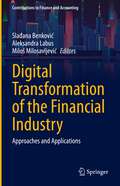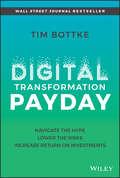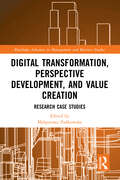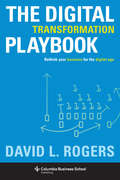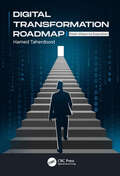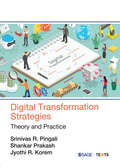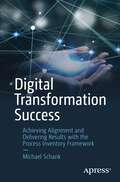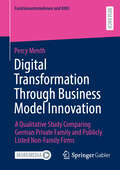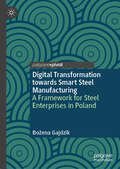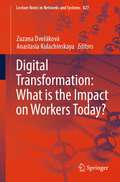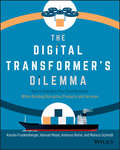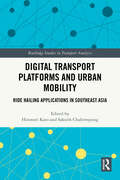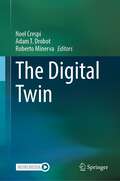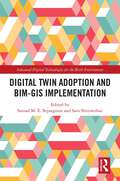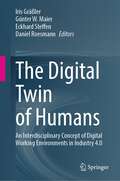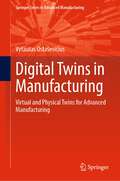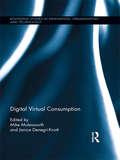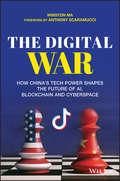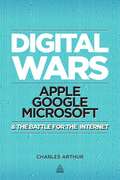- Table View
- List View
Digital Transformation of the Financial Industry: Approaches and Applications (Contributions to Finance and Accounting)
by Slađana Benković Aleksandra Labus Miloš MilosavljevićThis book presents a collection of state-of-the-art research findings on the digital transformation of financial services. Digitalization has fundamentally changed financial services and has a tendency to reshape the landscape of the financial industry in an unprecedented manner. Over the last ten years, the development of new financial technologies has contributed to the creation of new business and organizational models, along with new approaches to service delivery. By encompassing significant conceptual contributions, innovations in methods and techniques, and by delineating the main applications of digital transformation in Central and Eastern Europe (CEE), the volume extends current knowledge on digital transformation in the financial industry. The book is divided into two parts. The first part provides a social-science perspective on digital transformation in the financial industry. The second part provides the most recent evidence on how financial technologies are transforming financial services on the markets, and how the adoption of modern information technologies fosters setting up new financial services. Further, this part outlines new approaches to digital transformation in the financial industry.This book will appeal to students, scholars, and researchers of finance, monetary economics, and business, as well as practitioners interested in a better understanding of the digital transformation of financial services, new financial technologies, and innovations in finance.
Digital Transformation of the Hotel Industry: Theories, Practices, and Global Challenges (Tourism, Hospitality & Event Management)
by Jorge Marques Rui Pedro MarquesThe hotel industry has gone through important transformations, not only in terms of management and operation but also in terms of interaction with consumers. Technological development and adaptation to the digital era have been one of the greatest challenges for hotels. This book aims to fill the gap in the literature in this specific area of the tourism sector and contribute to a better understanding of trends and challenges in the hotel industry on a global scale.
Digital Transformation Payday: Navigate the Hype, Lower the Risks, Increase Return on Investments
by Tim BottkeThe Data-Driven Guide for your Digital Transformation Payday In Digital Transformation Payday: Navigate the Hype, Lower the Risks, Increase Return on Investments, Tim Bottke, Senior Strategy Partner at Deloitte and Associate Professor for Strategy and Digital Transformation at SDA Bocconi, a Financial Times/Forbes/Bloomberg Businessweek Top-Five European business school, delivers a provocative, new perspective on digital business transformation—using research to get beyond the hype and uncover its real financial payback. Have you ever asked yourself: “Should I really embark on a digital transformation journey that is likely full of pain, failure, and high cash-outs? One that puts a lot of pressure on our stock price and my nerves? Who will thank me for that? Will there ever be a measurable return on invest for all these technologies that supports positive market value impact?” If so, this book is for you. You’ll find unique insights and guidance for managers, executives, board members, and investors as you navigate an immense array of strategic and operational choices, opportunities, and pitfalls. You’ll also learn to demystify digital strategy and technology buzzwords, better define the initial focal point and process of your firm’s digital transformation, and establish new ways of thinking in terms of value impacts—and how to measure them—right from the start. The book also includes: A proven framework for defining your next digital transformation effort end to end, and configuring your initiatives for maximum return on investment Empirical data to help you understand your company’s odds of navigating your chosen digital transformation initiatives with financial payback An indispensable resource for business leaders, Digital Transformation Payday will also earn a place in the libraries of entrepreneurs, founders, leaders of established companies, and digital enthusiasts.
Digital Transformation, Perspective Development, and Value Creation: Research Case Studies (Routledge Advances in Management and Business Studies)
by Małgorzata PańkowskaThis edited collection aims to provide relevant theoretical frameworks and the latest empirical research findings in the area of business management. It covers case studies provided by teachers visiting the University of Economics in Katowice, Poland, within Erasmus and CEEPUS Programmes. Over 12 years, approximately 25 teachers have been coming year by year to Katowice, presenting their monographic lectures and participating in seminars on their research results and educational achievements. This book contains descriptions of case studies, elaborated by Erasmus and CEEPUS teachers, illustrating that the case study is a method of research as well as a method applied in education and emphasizing the value of qualitative methods by example of case studies. The key benefit of qualitative research is that it allows a researcher to perceive and understand context within which decisions and actions take place. Hence, to understand peoples’ motivations, their reasons, their actions, and the context for their beliefs and actions, qualitative research is the best route. Assuming that business organizations as well as individuals are entirely linked together via the Internet, a new approach to business communication and marketing, business modelling and management are developed to reveal an increase of business synergy effects, the alignment of information and communication technologies (ICT) and business and social value creation, as well as sustainability and environment protection. Through this book, readers have an opportunity to learn about relevance and rigor in qualitative research and how the case study can be applied in various organizational contexts.
The Digital Transformation Playbook: Rethink Your Business for the Digital Age (Columbia Business School Publishing Ser.)
by David RogersRethink your business for the digital age.Every business begun before the Internet now faces the same challenge: How to transform to compete in a digital economy?Globally recognized digital expert David L. Rogers argues that digital transformation is not about updating your technology but about upgrading your strategic thinking. Based on Rogers's decade of research and teaching at Columbia Business School, and his consulting for businesses around the world, The Digital Transformation Playbook shows how pre-digital-era companies can reinvigorate their game plans and capture the new opportunities of the digital world.Rogers shows why traditional businesses need to rethink their underlying assumptions in five domains of strategy—customers, competition, data, innovation, and value. He reveals how to harness customer networks, platforms, big data, rapid experimentation, and disruptive business models—and how to integrate these into your existing business and organization.Rogers illustrates every strategy in this playbook with real-world case studies, from Google to GE, from Airbnb to the New York Times. With practical frameworks and nine step-by-step planning tools, he distills the lessons of today's greatest digital innovators and makes them usable for businesses at any stage.Many books offer advice for digital start-ups, but The Digital Transformation Playbook is the first complete treatment of how legacy businesses can transform to thrive in the digital age. It is an indispensable guide for executives looking to take their firms to the next stage of profitable growth.
The Digital Transformation Playbook: Rethink Your Business for the Digital Age
by David L. RogersThe fast-moving digital environment has been disorienting for traditional businesses, and many may not even realize their strategies are outdated. If managed correctly, lagging businesses can transition by harnessing the power of the digital age to create new value for customers and outperform their competitors. Drawing on years of experience as an educator, researcher, and consultant, David L. Rogers identifies five key rules-and provides practical, hands-on tools-that will help businesses of all sizes adapt, innovate, and maximize value creation.Rogers's rules address critical categories for every business: customers, competition, data, innovation, and the value proposition. For each, he presents diverse case studies (from companies such as Apple and Uber to GE and the New York Times), discusses common challenges to adopting the digital approach, and provides companies and business leaders clear, tested steps to implement new practices. Rogers shows that, rather than being "disrupted" by digital business models, any business can learn the rules of today's leading digital enterprises. This playbook is all business leaders need to create and pursue a digital plan that works.
The Digital Transformation Roadmap: Rebuild Your Organization for Continuous Change
by David RogersToday, every business is talking about digital transformation. With the acceleration of new technologies, every organization knows it must adapt to survive. But by their own admission, 70 percent of businesses are failing to transform. Across industries, established companies are held back by bureaucracy, inertia, and old ways of working. How can businesses break through to drive real change?The Digital Transformation Roadmap provides every leader with the answer. Acclaimed author and C-suite advisor David L. Rogers argues that businesses must transform not just products and business models—they must transform the organization itself. Based on two decades of research and advising companies around the world, Rogers identifies the five biggest barriers to digital transformation: vision, priorities, experimentation, governance, and capabilities. He then shows how any business can evolve by heeding the lessons of companies such as Disney, Walmart, Mastercard, Air Liquide, and the New York Times Company.The Digital Transformation Roadmap provides a practical blueprint for organizational change, illustrated with real-world case studies and step-by-step planning tools. Rogers shows every leader how to think beyond the churn of new technologies and rebuild their organization for a world of constant change.
Digital Transformation Roadmap: From Vision to Execution
by Hamed TaherdoostIn a world undergoing rapid technological evolution, this is your indispensable guide to thriving in the digital age. Digital Transformation Roadmap: From Vision to Execution offers a comprehensive exploration of the Fourth Industrial Revolution by presenting a roadmap for leveraging technology to revolutionize businesses, strategy, and innovation.Embark on a journey that unveils the dynamic interplay between technology and business. Discover the evolution of tech life cycles, the significance of digital transformation, and the key domains of change reshaping industries. Explore strategies to gain competitive advantage, from reimagining business models to aligning digital visions with organizational goals. Experience a holistic approach to digital transformation.Learn how to empower employees, foster a culture of innovation, and navigate change adeptly. Delve into the world of emerging technologies such as AI, IoT, and blockchain, and harness their potential to open new avenues for growth.From cybersecurity roadmaps to measuring system performance, uncover essential practices to ensure the resilience and success of digital initiatives. Master the art of delivering exceptional digital customer experiences and harnessing the value of data.Whether you’re a business leader, strategist, or tech enthusiast, this book equips you with actionable insights, practical strategies, and a forward-thinking mindset to drive change and thrive in the digital landscape.
Digital Transformation Strategies: Theory and Practice
by Srinivas R. Pingali Shankar PrakashThis textbook offers a unique combination of theory, practical applications and case studies on digital transformation strategies. Digital transformation is the process of changing conventional business models enabled by digital technologies. This involves strategically deploying digital technologies to create differential value of an organization. Digital transformation encompasses strategy changes, business model innovation, product and process innovation, and organizational innovation, all wrapped in a layer of newer technologies. This textbook helps define transformation and digitalization and contrasts them with digitization and automation. The book also presents a comprehensive digital strategy framework and describes each of its elements through several examples and exhibits. It provides useful insights into industry-specific cases, suggests detailed templates for digital implementation, and describes the risks in execution of digitalization and potential mitigation strategies. Key Features: • Covers all the key aspects of digital transformation required to build a career in consulting and implementation of digital strategy in business • Cases and examples from multiple industrial sectors to aid understanding of real-life practices and implementation of digital transformation • Structured in a reader-friendly manner to engage students, instructors, and junior and mid-level executives • Assumes no prior understanding of strategy, product development or process innovation
Digital Transformation Success: Achieving Alignment and Delivering Results with the Process Inventory Framework
by Michael SchankDiscover the key to digital transformation success in this comprehensive guide. In today's rapidly advancing technological landscape, companies are promised innovative business models, enhanced customer experiences, and productivity improvements through digital initiatives. However, it's disheartening that 70% of these endeavors fail to meet their goals, resulting in lost investments and frustrated stakeholders.The root cause of these failures often lies in the lack of alignment across organizations. Achieving alignment is crucial, encompassing both vertical alignment – which involves aligning goals from the CEO down to even low-level single contributors – and horizontal alignment – which enables seamless collaboration across functional areas. To address this challenge, the book introduces Process Inventory, a powerful framework that not only establishes a common language but also aligns resources throughout the organization, driving a new level of operating efficiency and agility necessary to thrive in this digital era. This comprehensive guide delves beyond guiding principles, providing readers with detailed methods, modeling techniques, operating models, and real-world case studies. By leveraging the Process Inventory framework, organizations can enhance existing disciplines like Change Management, Risk Management, and Operational Excellence, enabling effective digital technology design and propelling them into the forefront of the digital age.What You'll LearnThe transformative power of the Process Inventory framework to drive Digital Transformation success by aligning resources, organizational goals, and efforts, leading to unparalleled agility. How the Process Inventory serves as the connective tissue that redefines how an organization operates, enabling operational excellence and enhanced efficiency.How Process Inventory directly supports the seamless implementation of cutting-edge digital technologies like machine learning, intelligent process automation, and microservices.Key best practices, including building and maintaining models, engaging stakeholders, and attaining maximum value from this framework. How Process Inventory seamlessly integrates with and elevates existing disciplines such as Process Modeling, Enterprise Architecture, Risk Management, Lean/Six Sigma Process Improvement, Change Management, and Business Architecture. Who This Book Is ForForward-thinking Business Executives committed to achieving their digital transformation agendaVisionary Leaders, including COOs and CIOs, striving to elevate their organization's efficiency and effectivenessIndividual practitioners and teams dedicated to driving transformation strategies and techniques within their organizationProcess Center of Excellence personnel entrusted with mapping out and managing processes for their organization's success
Digital Transformation Through Business Model Innovation: A Qualitative Study Comparing German Private Family and Publicly Listed Non-Family Firms (Familienunternehmen und KMU)
by Percy MenthAssumed a variance between the established paths and opportunities occurring from the new, digital technologies, the aim of this book is to better understand why firms can struggle on digital transformation through business model innovation. In depth, Percy Menth studies, what specific characteristics of German private family firms and publicly listed non-family firms can influence potential struggling. Furthermore, the aim of this book is to identify ways, how both could benefit from one another. Therefore, the author analyses interviews with 30 owners and C-level managers from 30 German private family firms and 20 C-level managers of 15 German publicly listed non-family firms facing digital transformations. This study’s key finding is, that it is not the firms’ nature, that may primarily foster digital transformation and business model innovation, but rather people, who could make the difference between struggling and success.
Digital Transformation towards Smart Steel Manufacturing: A Framework for Steel Enterprises in Poland
by Bożena GajdzikThis book presents the impact of digital transformation and other megatrends on the steel industry, focusing on the digitization of processes, and the automation and robotization of operations in steel companies. Technological innovations in the steel industry are presented, as well as the changes taking place within the supply chains An essential part of the book is the results of direct research, which deal with the transformation of enterprises to smart steel manufacturing. The research was done on the Polish steel market, which is an open market with foreign capital. Exploring a sample of representatives of steel companies that serve both domestic and foreign markets, this book discusses the implementation of the pillars of Industry 4.0 as well as the strategic transformation of the steel industry.
Digital Transformation: What is the Company of Today? (Lecture Notes in Networks and Systems #805)
by Andrea Bencsik Anastasia KulachinskayaThis book offers the latest research on organizational management, knowledge management, organizational functioning, organizational digitalization, and other issues of modern company development. The book proposes to look at the pool of these problems through the prism of building various models for implementing digital transformation of business and processes. This book is intended for both young and experienced scientists who want to get acquainted with latest trends and data to use them in their research.
Digital Transformation: What is the Impact on Workers Today? (Lecture Notes in Networks and Systems #827)
by Zuzana Dvořáková Anastasia KulachinskayaThis book offers the latest research on formation of modern workers in the context of digitalization: from constant improvement of new training technologies to growing requirements for employees in workplace, as well as an assessment of specialists' digital skills and dynamics of changes over the past years. The book proposes to look at the pool of these problems through the prism of acquisition of new digital competencies and requirements for a modern worker. This book is intended for both young and experienced scientists who want to get acquainted with latest trends and data to use them in their research.
The Digital Transformer's Dilemma: How to Energize Your Core Business While Building Disruptive Products and Services
by Karolin Frankenberger Hannah Mayer Andreas Reiter Markus SchmidtBring your company into the digital era without compromising your core business In The Digital Transformer's Dilemma: How to Energize Your Core Business While Building Disruptive Products and Services, the authors show companies how to go digital while also advancing their core business. The book emphasizes how to strike a difficult balance between establishing a new (digital) business and re-vitalizing – and digitizing – the legacy business. The core of the book is focused on the actual implementation of the digital transformation across both businesses, providing concrete tips, tricks, tools and action plans across six key dimensions: Crafting a flexible organization Using technology as a driver Designing the necessary processes Building transformational leaders “Right-skilling” the workforce of the future Galvanizing cultural change The Digital Transformer’s Dilemma is a very visual book, filled with dozens of engaging illustrations that bring the contained concepts to life on the page. Based on 100+ interviews with senior executives at leading companies (such as Nestlé, Novartis, Volkswagen, BNP Paribas, BASF and Michelin) and smaller hidden champions, numerous illuminating case studies, and the authors’ own experience from working in international management consulting and years of academic experience, the book highlights the fundamental principles required for executives and businesspeople to transform legacy organizations into digitally empowered companies.
Digital Transitioning in the Built Environment of Developing Countries
by Innocent Musonda Adetayo Onososen Thembani MoyoThis book serves as a helpful guide for anyone interested in understanding and implementing Building Information Modelling (BIM) in developing countries. It focuses on the construction industry and how digital technologies can improve the way buildings and infrastructure projects are planned, designed, and built. The book starts by explaining what BIM is and why it's important. It then explores the challenges that developing countries face when adopting BIM, such as limited resources and lack of infrastructure. The authors provide practical solutions to overcome these challenges based on real-world examples and case studies. The book takes readers through a step-by-step process to create a roadmap for BIM adoption. It helps readers understand the necessary steps and strategies involved, such as setting clear goals, involving all relevant stakeholders, and managing changes in the way things are done.One of the book's unique features is that it focuses specifically on the needs and circumstances of developing countries. It recognises that these countries have different challenges compared to more developed nations. By addressing these specific challenges, the book provides tailored advice that readers can apply in their own contexts. The book also emphasises the need for training and capacity building. It acknowledges that many professionals in developing countries may not have the necessary skills and knowledge to fully utilise BIM. Therefore, it introduces an approach called the dynamic capacity model, which helps ensure that people receive the training they need to successfully implement BIM. Overall, this book is a practical and accessible resource for anyone interested in implementing BIM in the construction industry of a developing country. It is important reading for professionals and academics in construction management, engineering, architecture, infrastructure development, urban planning, and governance in developing nations.
Digital Transport Platforms and Urban Mobility: Ride Hailing Applications in Southeast Asia (Routledge Studies in Transport Analysis)
by Hironori Kato Saksith ChalermpongThis book offers comprehensive state-of-the-art knowledge of how ride-hailing applications (RHAs) are changing the landscape of urban mobility in developing Southeast Asia by examining the disruptions they cause, the impacts of RHAs on the transportation system, and public policy responses aimed at mitigating these impacts.Providing new perspectives on the familiar issues by taking the local contexts of middle-income SEA into account, where abundant and diverse modes of informal transportation thrive amidst rapid urbanization and motorization, the book also draws lessons based on empirical evidence on how public interventions can benefit urban mobility for other developing countries. Each city-specific chapter sets the stage by overviewing the city and its transportation system, and delves into the specifics of its RHA market, such as market structure and demand characteristics. Impacts of RHAs on other transportation operators as well as responses from affected parties are discussed, followed by the ensuing regulatory efforts and their outcomes. Findings from each city are internationally compared and lessons drawn from them that are useful for policymaking. The book will present insights into useful and effective policy interventions pertaining to RHAs, including how the new technology may affect the infrastructure investment decision and how RHA may be leveraged as an intervention tool in urban mobility in developing countries.Digital Transport Platforms and Urban Mobility provides academics and upper level students with in-depth knowledge and practices of the disruptive technology in urban transportation due to the advent of mobile ride-hailing applications in Southeast Asian countries. It will be an invaluable resource for all those interested in transportation planning and policy, urban and regional planning, with a particular emphasis on sustainability.
The Digital Twin
by Noel Crespi Adam T. Drobot Roberto MinervaThe Digital Twin is crucial and timely for positively affecting how we work, live, and play. It eliminates the gap between experimentation and learning by bridging real and virtual worlds in a powerful methodology, making significant headway in conquering previously unsolvable problems and challenges. Digital Twins are made possible by four widely deployed infrastructures for connectivity, computing, digital storage, and sources of digital data. The Digital Twin provides insights, paths to innovation, efficient production of goods, improved delivery of services, better experiences and entertainment, and new business models. Investing in Digital Twins is one of the most valuable ways to create sustainable paths to the future. The Digital Twin book is the most comprehensive work on the subject to date. It brings together top practitioners, technical experts, analysts, and academics to explore and discuss the concept of the Digital Twin, its history, evolution, and the profound impact across sectors of the global economy. The book addresses the business value, technological underpinnings, lessons learned from implementations, resources for success, practical approaches for implementation, and illustrative use cases. It makes the case for why we believe that Digital Twins will fundamentally transform major industries and enable us to fulfill important societal goals. The book is recommended for key decision makers, senior executives, technical leaders, researchers, and students.
Digital Twin Adoption and BIM-GIS Implementation (Advanced Digital Technologies for the Built Environment)
by Sepasgozar, Samad M. E. Sara ShirowzhanThe aim of this edited book volume is to present new concepts, and applications of Digital Twin and relevant tools in the built environment context. The book identifies key organisational factors that influence the adoption of technology within the architectural service industry, setting the stage for a deeper understanding of the shift towards digital methodologies.The book introduces the Digital Twin Readiness Level framework, a modified metric system with ten levels of risk‑based maturity and an empirical development of a Digital Twin Adoption Model. Furthermore, the text ventures into immersive virtual environments and their applications, showcasing innovative practices that enhance learning and operational efficiency.Additionally, the book examines the integration of Building Information Modelling (BIM) and Geographic Information Systems (GIS), revealing new workflows for creating 3D models of cities. A focus on Australia’s government‑funded infrastructure projects offers insights into the values and acceptance criteria for these technologies, providing a comprehensive overview of their practical implications and future potential. This book is essential reading for practitioners, engineers, and managers involved in any phase of the built environment from design to operation and other architectural, engineering, and construction (AEC) stakeholders who are a part of digital transformations, as well as researchers, educators, and students interested in the field.
The Digital Twin of Humans: An Interdisciplinary Concept of Digital Working Environments in Industry 4.0
by Iris Gräßler Günter W. Maier Eckhard Steffen Daniel RoesmannThis book provides an interdisciplinary concept of digital working environments in industry 4.0 to enable the implementation of the digital twin of humans.Information and communication technology is penetrating all areas of daily life at a rapid pace in private and professional areas. These technologies enable companies to aggregate huge volumes of data. Collected personal data of employees creates the opportunity of a digital representation of the human being itself, that is conformant with the definition of a digital twin. These digital twins of humans include selected characteristics and behaviour of the humans, that are linked to models, information, and data. According to existing trend studies, the digital twin of humans is a technology that will have a significant impact on the economy, society, and people. It is important to consider the regulatory framework for the use of personal data and threats of misuse.This book will be of use to researchers and professionals in industry.
Digital Twins: Basics and Applications
by Zhihan Lv Elena FersmanThis book comprehensively introduces readers to Digital Twins, from the basic concepts, core technologies and technical architecture, to application scenarios and other aspects. Readers will gain a profound understanding of the emerging discipline of Digital Twins. Covering the latest and cutting-edge application technologies of Digital Twins in various fields, the book offers practitioners concrete problem-solving strategies. At the same time, it helps those working in Digital Twins-related fields to deepen their understanding of the industry and enhance their professional knowledge and skills. Given its scope, the book can also be used as teaching material or a reference book for teachers and students of product design, industrial design, design management, design marketing and related disciplines at colleges and universities. Covering a variety of groundbreaking Digital Twins technologies, it can also provide new directions for researchers.
Digital Twins in Manufacturing: Virtual and Physical Twins for Advanced Manufacturing (Springer Series in Advanced Manufacturing)
by Vytautas OstaševičiusThis book presents a guide to digital twin technologies and their applications within manufacturing. It examines key technological advances in the area of Industry 4.0, including numerical and experimental models and the Internet of Things (IoT), and explores their potential technical benefits through real-world application examples. This book presents digital models of advanced manufacturing processes dynamics that enable to control the cutting processes including experimental and simulation studies for brittle-ductile transition of ultra-precision machining materials assuring product quality. Innovative electrical power harvesting solutions from tool vibrations and wireless data transmission from confined and heavily cooled environment are also included. It explains the benefits of virtual and physical twins adapted to real systems, including the ability to shorten the product's path to the market, and enabling the transition to higher value-added manufacturing processes. Including numerous illustrations and clear solved problems, this book will be of interest to researchers and industry professionals in the fields of mechatronics, manufacturing engineering, computational mechanics.
Digital Virtual Consumption (Routledge Studies in Innovation, Organizations and Technology)
by Janice Denegri-Knott Mike MolesworthDigital media present opportunities for new types of consumption including desiring, buying, collecting, making, and even selling digital virtual goods. To these activities we can add those taking place in virtual communities of consumption, online shops, brand websites, and online auction houses that together amount to a vast new landscape of consumption. Digital virtual consumption motivates concatenated practices which produce meaningful experience for their users as well as market opportunities to profit from them. Consumers create and maintain elaborate wish lists, engaging with simulations of brands on websites and in videogames, coveting items for use in online games and even spending ‘real’ money on these, undertaking entrepreneurial activity in virtual worlds, conjuring nostalgia via online auctions, engaging in playful consumption in other new retail formats, writing reviews of products as part of the consumption experience, engaging in online activist activities, and many other emerging behaviors. Analyses of consumption in the digital virtual realm are however limited. This collection brings together experienced researchers from the fields of consumer research, digital games, and virtual worlds to provide conceptual and empirical work that helps us understand these new and significant consumer activities. Online communities negotiate the ‘correct’ use of goods and offer technical advice, consumers develop new products, individuals create and distribute their own promotional material for their favorite brands, and entrepreneurial consumers marketing and selling their own products online. Here we may see a blurring of consumption and production, or work and leisure activity that requires further thought about what makes it meaningful for individuals. The chapters in this volume take stock of the emergence and likely importance of digital virtual consumption for consumer culture, including a review of both new and existing conceptual and methodological tools as well as a resource of key examples and analyses of practices.
The Digital War: How China's Tech Power Shapes the Future of AI, Blockchain and Cyberspace
by Winston MaWhat new directions in China’s digital economy mean for us all China is the largest homogenous digital market on Earth: unified by language, culture, and mobile payments. Not only a consumer market of unrivaled size, it’s also a vast and hyperactive innovation ecosystem for new technologies. And as China’s digital economy moves from a consumer-focused phase to an enterprise-oriented one, Chinese companies are rushing to capitalize on ways the newer wave of tech—the Internet of Things, AI, blockchain, cloud computing, and data analytics (iABCD)—can unlock value for their businesses from non-traditional angles. In China’s Data Economy, Winston Ma—investment professional, capital markets attorney, adjunct professor of digital economy, and bestselling author—details the profound global implications of this new direction, including how Chinese apps for services such as food delivery expand so quickly they surpass their U.S. models within a couple of years, and how the sheer scale and pace of Chinese innovation might lead to an AI arms race in which China and the U.S. vie aggressively for leadership. How China’s younger netizens participate in their evolving digital economy as consumers, creators, and entrepreneurs Why Online/Office (OMO, Online-merge-with-Offline) integration is viewed as the natural next step on from the O2O (Online-to-Offline) model used in the rest of the world The ways in which traditional Chinese industries such as retail, banking, and insurance are innovating to stay in the game What emerging markets can learn from China as they leapfrog past the personal computer age altogether, diving straight into the mobile-first economy Anyone interested in what’s nex
Digital Wars
by Charles ArthurApple, Google and Microsoft are locked in a battle to dominate the internet and especially the fastest-growing part of it - mobile. All three have fought each other in previous wars, and now they want to dominate search technology, cloud computing, mobile music and the smartphone market. Whoever wins will exert a wide ranging control over user data and access to content, and even how we use and interact with computers. Digital Wars assesses who will be the victor and what the implications are for business, individuals and society. Accessible and comprehensive, it looks at the very different cultures of each business, the iPhone, Android, iPods (mobile music) and the browser and apps battles. Digital Wars tells you what to expect from the internet in the next five years, which company will ultimately be in the driving seat, and what the implications will be for us all.
